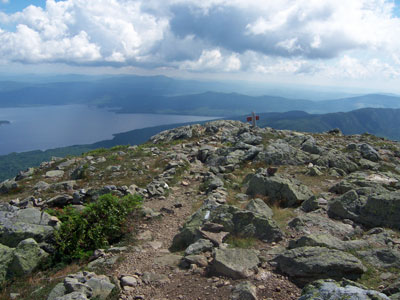DACF Home → Bureaus & Programs → Maine Natural Areas Program → Ecological Reserves → Bigelow Preserve
(Printer Friendly Version-62 KB pdf) (Download a free copy of Adobe Acrobat Reader)
Bigelow Preserve
Flagstaff Twp, T3 R4 BKP WKR, Bigelow Twp, Dead River Twp
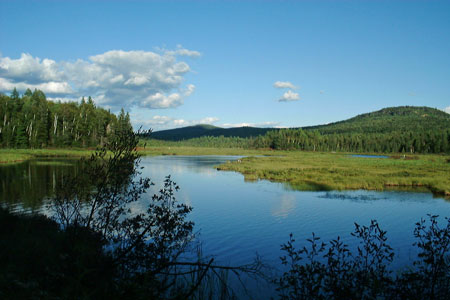
Vital Statistics
- Size: 10,540 acres
- Regulated: 4,341 acres
- Non-Regulated: 6,199 acres
- Upland: 10,331 acres
- Forested Wetland (NWI): 71 acres
- Non-Forested Wetland: 140 acres
- Open Water: 20 acres
- Roads: trails-23 miles
- Biophysical Region: Mahoosucs/Rangeley Lakes
- BPL Region: West
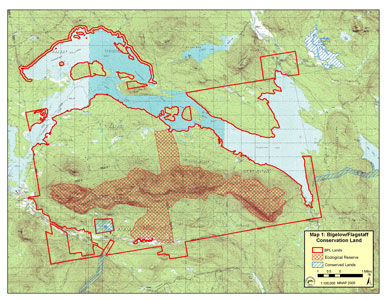
(Download a Printer Friendly Version-4 MB pdf-of this map.)
Exemplary Natural Communities
Rare Plants
| Scientific Name | Common Name | State Rank | Global Rank | State Status |
|---|---|---|---|---|
| Vaccinium boreale | Alpine Blueberry | S4 | GNR | SC |
| Anthoxanthum monticola | Alpine Sweet Grass | S1 | G5 | T |
| Carex bigelowii | Bigelow's Sedge | S2 | G5 | SC |
| Agrostis mertensii | Boreal Bentgrass | S2 | G5 | T |
| Solidago leiocarpa | Cutler's Goldenrod | S1 | G5T4 | T |
| Dryopteris fragrans | Fragrant Cliff Wood-fern | S3 | G5 | SC |
| Diapensia lapponica | Lapland Diapensia | S2 | G5 | SC |
| Minuartia groenlandica | Mountain Sandwort | S3 | G5 | SC |
| Geocaulon lividum | Northern Comandra | S3 | G5 | SC |
| Paronychia argyrocoma | Silverling | S1 | G4 | T |
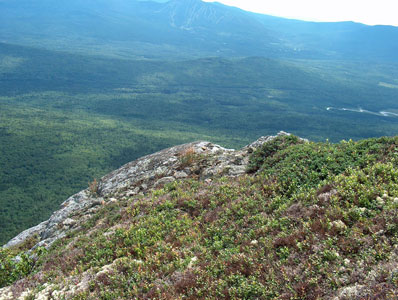
Rare Animals
There are no documented occurrences of rare animals within this Ecoreserve. For more information on rare animals in Maine, visit the Maine Department of Inland Fisheries and Wildlife.
Description
Extending over 3,000 feet from Flagstaff Lake (1140 feet) to West Peak (4150 feet), the Bigelow Ecological Reserve encompasses the highest elevational gradient of any of the 16 reserves. Its area of alpine ridge (171 acres) is second to the Mahoosucs among ecological reserves, and it supports over 3,100 acres of subalpine spruce-fir forest. Some of this sub-alpine forest has been harvested in the past, depending on forest type and accessibility. Nearly all of the sub-alpine type shows evidence of natural disturbance, spruce-budworm mortality and wind/ice damage. The Appalachian Trail traverses the eastern part of the ridge, and other hiking trails provide access from the south and west.
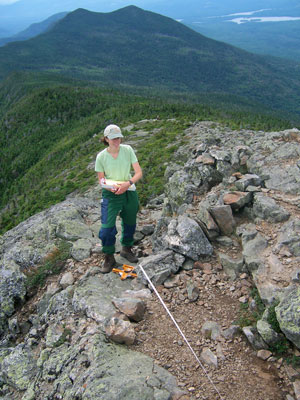
Operable mid-slope forests extend both north and south of the main ridgeline, affording opportunities to study the influence of aspect on forest characteristics. Most of the low to mid-elevation forests in the preserve were harvested several times in the last century. However, the reserve also supports small but good examples of two common matrix-forming natural communities, beech-birch-maple forest and montane spruce-fir forest. These stands show little evidence of past harvesting and support many trees over 110 years old.
Wetlands in and around the floodplain of Stratton Brook provide excellent examples of successional wetland systems from broad graminoid and shrub meadows and a convoluted mosaic of acidic fen, shrub swamp, and various graminoid and herbaceous meadows. All of the wetlands sampled in the 1990s had been influenced by beaver.
